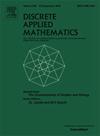图的多字可表示性
IF 1
3区 数学
Q3 MATHEMATICS, APPLIED
引用次数: 0
摘要
图G=(V,E)是词可表示的,如果在字母V上存在一个词w,使得对于任何不同的顶点对x,y∈V, (x,y)∈E当且仅当字母x和y在单词w中交替出现。词可表示的图推广了许多重要的图类,如3色图、可比性图和顶点度数最多为3的图。图的多词可表征性概念是对词可表征性概念的推广。图G是k-多字可表示的,如果它可以用一组最多k个字来表示,每个字表示G的一个可字可表示的子图,使得它们的并集是G。2-多字可表示的图包含许多图类,如可字可表示的图、平面图、间隔图、分割图和线形图。我们首先研究了寻找图的最大可词表示的诱导子图的问题。对于大小为9的图,我们解决这个问题。我们研究的第二个问题是确定是否有可能将n个顶点上的图划分为两个集合,每个集合产生一个词可表示的图。对于大小不超过13的图和大小不超过16的完美图,我们都可以解决这个问题。这些结果帮助我们证明,最多有20个顶点的图是两个多词可表示的。我们要解决的第三个问题涉及到计算完美图的某些子类的多词表示数。特别是,我们的研究揭示了具有多达28个顶点的完美图,良好划分的弦图和具有最多(25+y)个顶点的(6+y)-树,所有完美图的子类都是2-多词可表示的。此外,我们还证明了任何弦图都是O(对数)-多词可表示的。本文章由计算机程序翻译,如有差异,请以英文原文为准。
Multi-word-representability of graphs
A graph is word-representable if there exists a word over the alphabet such that for any distinct pair of vertices , if and only if the occurrences of the letters and alternate in the word . Word-representable graphs generalize many important graph classes such as 3-colorable graphs, comparability graphs, and graphs of vertex degree at most 3. The notion of multi-word representability of graphs is a generalization of the notion of word-representability. A graph is -multi-word-representable if it can be represented by a set of at most words, each representing a word-representable subgraph of , such that their union is . 2-multi-word-representable graphs contain many graph classes, such as word-representable graphs, planar graphs, interval graphs, split graphs, and line graphs.
We first investigate the problem of finding the largest word-representable induced subgraph of a graph. We solve this problem for graphs of size up to nine. The second problem that we study is determining whether it is possible to vertex partition graphs on vertices into two sets, each inducing a word-representable graph. We solve this problem for graphs of size up to thirteen and for perfect graphs of size up to sixteen. These results help us to show that graphs with at most 20 vertices are 2-multi-word-representable. The third problem we address involves computing the multi-word-representation number for certain subclasses of perfect graphs. In particular, our investigation reveals that perfect graphs with up to 28 vertices, well-partitioned chordal graphs, and -trees with at most vertices, all subclasses of perfect graphs, are 2-multi-word-representable. Additionally, we establish that any chordal graph is -multi-word-representable.
求助全文
通过发布文献求助,成功后即可免费获取论文全文。
去求助
来源期刊

Discrete Applied Mathematics
数学-应用数学
CiteScore
2.30
自引率
9.10%
发文量
422
审稿时长
4.5 months
期刊介绍:
The aim of Discrete Applied Mathematics is to bring together research papers in different areas of algorithmic and applicable discrete mathematics as well as applications of combinatorial mathematics to informatics and various areas of science and technology. Contributions presented to the journal can be research papers, short notes, surveys, and possibly research problems. The "Communications" section will be devoted to the fastest possible publication of recent research results that are checked and recommended for publication by a member of the Editorial Board. The journal will also publish a limited number of book announcements as well as proceedings of conferences. These proceedings will be fully refereed and adhere to the normal standards of the journal.
Potential authors are advised to view the journal and the open calls-for-papers of special issues before submitting their manuscripts. Only high-quality, original work that is within the scope of the journal or the targeted special issue will be considered.
 求助内容:
求助内容: 应助结果提醒方式:
应助结果提醒方式:


